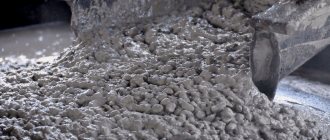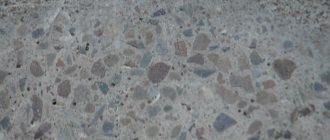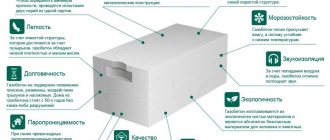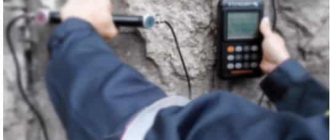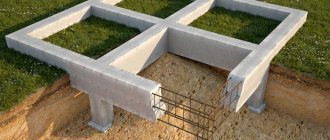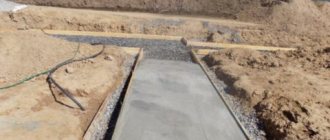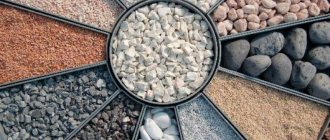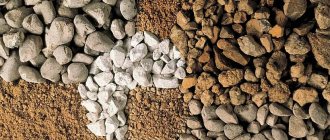The strength of concrete is a determining indicator of a concrete solution, which determines the tasks and conditions of its use. Concrete mixture is used everywhere in repair and construction work of private and industrial facilities. There are many recipes for preparing concrete; the composition and proportions of the components directly affect the properties and characteristics, as well as the scope of use of the cement mortar.
The strength of concrete is a defining characteristic that is displayed in the marking. The strength itself determines the brand and class of the solution. These indicators are indicated in various GOSTs, SNiPs, regulatory documents; they determine the performance qualities and properties of concrete elements, structures, buildings, etc.
Knowing the strength indicators of concrete is very important when performing any work, as it allows you to accurately perform calculations, select the right mixture of suitable grades and classes for a specific task, being confident in the strength, reliability and durability of the element or structure. Developers are required to check the strength of concrete for tension, compression, bending, etc. before starting work.
What indicators determine the strength of concrete:
- Grade - the value of average strength, denoted by the letter M, is in the range of 50-1000, depends on the volume and quality of cement in the mixture. Displays compressive strength in kgf/m2 28 days after pouring. The larger the number next to the index, the more durable the concrete is considered and the more expensive it is. A high-strength mortar is usually more difficult to work with: it hardens faster and is difficult to install.
- Class - guaranteed compressive strength, which a concrete product demonstrates in 95% of tests, is designated by the letter B, is in the range of 3.5-80, calculated in MPa.
Any class is equated to a specific brand (the same rule applies vice versa). Typically, design documents indicate the strength class, and purchase orders indicate the grade.
What is it and the main types
Trying to understand what the strength of concrete depends on, what it is and what the main types of indicator are, it is necessary to study all the main aspects of the process of preparing the mixture, composition, conditions and features.
Factors affecting the strength of concrete:
- The quality of the cement in the composition - the higher the grade of the binder itself, the stronger the concrete will be.
- The volume of cement in the solution is calculated per 1 cubic meter. The quality and quantity of cement are interrelated - if there is a large volume and a low grade or a high grade and insufficient quantity, the result will not be what is expected. It must be prepared according to the recipe specified in GOST and from a suitable brand of cement.
- The volume of water also directly affects the strength: an insufficient amount will lead to the impossibility of laying the mixture correctly, an excess volume contributes to a faster hydration process, which makes the concrete weaker due to the appearance of pores and cracks.
- Quality of aggregates – shape, fraction, purity. Fillers with a rough surface of irregular shape provide better adhesion of materials included in concrete (strength increases), dirty particles and a smooth surface reduce adhesion and strength, respectively.
- The quality of mixing the components - duration, method also influence: if the solution is mixed for less time than necessary, the components do not take their place in the dough and the strength decreases.
- The order of installation, the method of processing the joint after a break in installation - all this affects the quality and strength of the monolith.
- Vibration is a very important process that increases the tensile strength of concrete by an average of 10-30% compared to that which was compacted manually.
- Hardening conditions - temperature, humidity, on which strength largely depends. The highest performance is for a mixture that hardens in a humid environment with an average temperature, but in heat and dryness the solution quickly loses moisture and can become covered with cracks. At temperatures below zero, concrete stops hardening altogether.
- Freezing - if hardening has reached a certain point, temporary freezing of the monolith simply stops the process, then it continues without loss of properties. If concrete freezes at an early stage of the reaction, the final strength is significantly reduced.
Main types of concrete strength:
- Design – the one specified in the regulatory documents and assumes the ability of the monolith to fully withstand the specified loads after the full hardening period has passed (28 days).
- Regulatory - the one specified in the technical specifications or GOST.
- Actual - the average value, which is calculated based on the results of the tests.
- Required - the maximum permissible indicator for operation, which is established by the enterprise laboratory.
- Stripping - one in which you can dismantle the formwork and disassemble the forms.
- Release is the indicator at which it is allowed to ship the product to the consumer.
Types of strength regarding brand and quality: concrete strength in compression, bending, axial tension, as well as transfer strength.
Compressive strength
In the context of this characteristic, concrete can be compared to stone - it resists compression much better than tension. The main criterion for the strength of concrete is its compressive strength.
This indicator is considered the most important among all the technical characteristics of the solution - it affects the scope of use of the structure or element, ensures reliability and durability.
To determine the value, cube-shaped samples are poured from the solution and placed under a special press. The pressure gradually increases and at the moment when the sample cracks, the device screen records the value. The calculated compressive strength determines the class assigned to concrete. The mixture dries and hardens within 28 days (or more); at the end of this period, a check is carried out, since the mixture should already have reached the calculated/design strength.
Compressive strength is a characteristic of the mechanical properties of a material, resistance to loads and pressure. This is an indicator of the limit of resistance that the frozen solution has to the mechanical effects of compression, displayed in kgf/cm2. The M15 mixture has the lowest compressive strength, and the M800 mixture has the highest.
Compressive strength is displayed in both grade and grade. Class B is cubic strength, indicated in MPa. Grade M – compressive strength in kgf/cm2. Compliance data for brands, classes and indicators are shown in the table below.
Flexural strength
This indicator increases as the digital designation of the brand increases. Typically, flexural and tensile strengths are lower compared to the load capacity of concrete. Young concrete shows a value of 1/20, old concrete - 1/8. Flexural strength must be taken into account in the design before construction.
To understand what level of bending strength concrete exhibits, a blank is poured in the form of a beam with dimensions, for example, 60 x 15 x 15 centimeters (reference sample). Concrete is poured into molds, bayoneted, left for several days, then removed from the molds and allowed to completely harden for 28 days under optimal conditions: temperature at least 15-20 degrees and humidity up to 80-90%. Periodically, the samples are covered with raw sawdust (they are moistened regularly) or watered with water.
When the workpiece has completely hardened, it is placed on supports that are located at a certain distance, and a load is placed in the center, gradually increasing it until the sample is destroyed.
A special hydraulic press can be used for this. The dimensions of the beam and the distance between the two supports may vary.
Formula for calculating bending strength: R bend = 0.1 PL / bh2.
Here:
- L is the distance between supports
- P – load mass + sample mass
- b and h – width and height of the section of the sample (beam)
The value can be significantly increased to a certain value using reinforcement - this is a relatively inexpensive and effective method.
Axial tension
This parameter is, as a rule, not taken into account at all when designing load-bearing structures. It is important for determining the ability of concrete not to crack in the event of sudden changes in temperature/humidity. Tensile is a component of flexural strength.
The value of axial tension is quite difficult to determine. One of the methods used is stretching beam samples using special equipment provided for this. The concrete monolith also collapses under the influence of two opposite tensile forces. The ability to withstand axial tension plays an important role in the preparation of concrete used for road surfaces and tanks, where cracks are simply not acceptable.
As a rule, fine-grained compositions demonstrate a higher tensile strength compared to coarse-grained ones (assuming a similar compressive strength).
This indicator is designated by the letters Bt and is in the range of 0.4-6 MPa.
Transfer strength
This type of strength is a standardized indicator of stressed elements when stress is transferred to it from reinforcing parts. Transfer strength is indicated in regulatory documents and specifications for a particular type of product. Usually a minimum of 70% of the design grade is assigned, which directly depends on the properties of the reinforcement.
The recommended value is considered to be at least 15-20 MPa, taking into account the type of reinforcement. If we denote transfer strength, then this is an indicator that demonstrates the level at which the reinforcing rods do not slip from the conductors when removed.
The minimum Rbp value ensures the crack resistance and strength of the product during crimping, transportation and lifting. The lower the Rbp, the greater the creep losses and the higher the compression force. But the higher the Rbp, the longer the heat treatment must be, the more expensive the design is. Based on experience, many experts indicate that the optimal Rbp is 0.7 V.
Determination of the strength of concrete in compression, bending, tension and splitting according to GOST 10180-78
The compressive strength of concrete is determined using a hydraulic press. Before installing the sample, the press is thoroughly cleaned and the working surfaces of the plate press and the sample are wiped with a dry cloth. The sample is installed so that the direction of the load is parallel to the layers of laying the concrete mixture (cylinders and prisms are installed vertically, and cubes are usually upside down with their side faces), centered by the marks applied to the press plate. Having turned on the press, the sample is loaded continuously and uniformly at a speed of (0.6 ± 0.2) MPa/s until the sample is destroyed. The breaking load Рр is fixed on the force-measuring scale of the press according to the indication of a passive arrow, which, after reducing the destructive force РР, remains in place. Compressive strength
where α is the conversion factor to the reference cube (15x15x15 cm) is taken according to the data given below:
| Sample shape | cubic | Cylindrical | ||||||
| Sample size (fin or diameter), cm | 7,07 | 10 | 20 | 30 | 7,14 | 10 | 15 | 20 |
| Coefficient α | 0,85 | 0,91 | 1,05 | 1,1 | 1,16 | 1,17 | 1,20 | 1,24 |
The cross-sectional area of the sample is determined as half the sum of the areas of the supporting faces.
With three samples in a series, three values are obtained (smaller, larger and intermediate). If both the smaller and larger values differ from the intermediate value by no more than 15%, then the strength of concrete is taken according to the arithmetic average of the three Rcom values. If the difference is larger, the compressive strength will be the intermediate Rcom value
The bending strength of concrete is determined using square prism samples with dimensions of 10X10X40, 15X15X60 and 20XX20X80 cm.
The bending test is carried out according to the diagram (Fig. 43); The testing device consists of a table 4 with two cylindrical supports 5 for installing the test sample on them/and a rigid upper crossbeam 2 with two cylindrical supports 3 for transferring the load from the press to the sample. It is necessary to ensure that the prism on the supports and the supports on the prism rest tightly across the entire width, all supports are perpendicular to the axis of the prism, and the axes of the prism and traverse are in the same plane. The prisms must be installed so that the bending plane is parallel to the layers of concrete mixture. The load on the sample must increase uniformly at a rate of (0.05±0.02) MPa/s until the sample fails. Bending strength
where Рр is the breaking load, N; l — distance between supports, cm; a is the side of the square section of the beam, see
Strength limit of concrete under axial tension
The flexural strength of concrete is calculated as the arithmetic mean value Rр
for all samples of this series, the strength of which differs by no more than 15%, and the destruction occurred in the middle third of the test span. When testing a prism with dimensions 20X20X80 cm, the “reference” strength of a sample with dimensions 15x15x60 cm is determined by an increase in the obtained values by 5%, and for prisms 10X10X40 cm - by a decrease of 5%.
The tensile strength of concrete is determined directly (axial, tensile test) and indirectly (splitting test). Tests for axial tension include square-section figure-of-eight specimens with thickenings at the ends (Fig. 44), in which reinforcement and mounting loops made of steel with a diameter of 6 mm are located, protruding beyond the ends of the specimen and serving for fastening in a tensile testing machine. When stretched, the sample collapses (breaks) in the middle, thinner working part, which may have a cross-section. 10X10, 15X15 or 20X20 cm.
Sample cubes or cylinders are tested for splitting, as in the compression test (the cubes must have chamfers 14 mm wide on two opposite edges). The samples are placed in the press so that the compression force is directed along the axis, and the cylinder rests along the generatrix (the compression force is directed along the diameter - Fig. 45). The sample splits due to transverse tensile deformations, so the splitting force is an indirect characteristic of the tensile strength of concrete.
Tensile strength of concrete when splitting
, or
where Pр is the breaking load, N; a—cube edge size, cm; d—cylinder diameter, cm; l is the length of the cylinder, cm.
Table 24
| Purpose of concrete | Strength limit of concrete, MPa, at | |
| compression | stretching and bending | |
| Single layer coating and double layer top layer | 30, 35, 40, 50 | 4; 4,5; 5; 5,5 |
| Bottom layer of two-layer coating | 25, 30, 35. | 3,5; 4; 4,5 |
| Improved Capital Covering Foundation | 7,5; 10; 15; 20; 25 | 1,5;, 2,2;. 2,5; 3; 3,5 |
Cement concrete used for road construction, depending on its compressive strength, is divided into the following classes: B7.5; AT 10 O'CLOCK; B 12.5; B15; IN 20; B25; B30; B35; B40 and B50:
Depending on the tensile strength, concrete for road construction is divided into classes: Bt1.2; Bt1.6; Вt2; Bt2.4; Bt2.8; Bt3,2.
For road and airfield pavements and foundations of various types, the strength of concrete in compression and tension during bending must comply with the requirements of GOST 8424-72 (Table 24).
WOOD
Methods for determining strength
Understanding how to determine the strength of concrete, you can more accurately draw up design documentation and perform calculations for certain structures. As a rule, the strength of concrete is determined in a laboratory, using special instruments, on control samples and selected samples. Tests are controlled and regulated according to GOST adopted for a particular type of concrete mixture.
In addition, the strength of concrete is determined at the construction site during the work process, which makes it possible to control the quality of the mixture.
There are two main methods for determining the strength of concrete: destructive and non-destructive. Usually, the strength of concrete at an intermediate age is not determined; most often, already hardened samples or pieces of a monolith are used.
Destructive way
This group of methods requires the destruction of a prototype, which is prepared from a control sample of concrete mortar or is removed from the monolith with a diamond drill. Sawed cylinders or poured cubes are crushed under a press. The load is increased continuously, evenly over a not very long time, until the control sample fails. The results of critical loads are recorded, and then the indicators are calculated.
The destructive method is the most accurate of all used to determine the strength of concrete. Thus, examining a building by crushing concrete samples makes it possible to determine the compressive strength of the monolith. According to current SNiPs, this is a mandatory procedure before putting a structure into operation.
Non-destructive method
This group of methods does not require destruction of samples and may not involve their use at all. Tests are carried out using various tools and devices.
Types of non-destructive research methods by type of tools used:
- Impact
- Partial destruction
- Ultrasound examination
The impact method is based on the application of impact-type force to a concrete surface.
Three main ways to study impact strength:
- Elastic rebound – the magnitude of the rebound from the striker striker monolith is determined.
- Impact impulse method – the force of the impact and the resulting energy are recorded.
- Plastic deformation is a force applied to a concrete monolith by a device with stamps in the form of a disk or ball attached to its impact surface. Strength is calculated according to the depth of the impact marks.
Partial destruction involves a local impact on the concrete monolith and damages it slightly.
Partial destruction methods:
- Chipping - involves a mechanical sliding effect on the edge of the structure with fixation of forces that provoke splitting of the area.
- Tear-off - involves attaching a metal disk to a section of the monolith using special glue, and then tearing it off. The force required to destroy the material is recorded and used to calculate the strength index.
- Tear-off with chipping - gives more precision: anchor devices are fixed to a section of the monolith, then they are torn off.
Ultrasound examination involves the use of a special device that produces ultrasonic waves. The process determines the speed of ultrasound that passes through the concrete structure. In this way, both the surface of the concrete and its deep layers are examined. But there is an error in the calculations.
Tensile Strength of Concrete
Many branches of construction use concrete. This is due to the strength of the material. The compression indicator is the highest among analogues, and the bending and tensile strength is inferior to the materials.
It is difficult to find out the properties of concrete if you only have knowledge of computational quantities and the ratio of components. Therefore, methods and techniques are used to test concrete.
Tensile testing of concrete
Concrete is not used for tensile work. It is important to know the tensile strength limit. Then the magnitude of the load at which cracks will form, deforming the integrity of the structure, will become known. The tests are also useful in preventing decomposition and corrosion.
Cracks occur after the use of high-strength steel reinforcement and after exposure to the shear force of diagonal stress. A common cause of cracks is temperature changes and shrinkage of the building.
Tensile forces without numbers in the characteristics of the conical section or the degree of deviation from the circle are difficult to create; this is possible when exposed to secondary stress by concreted rods.
For such problems, the tensile strength of concrete is measured by the bending of a straight unreinforced concrete beam. The tensile stress during the formation of the lower threads of the tested part is the bending strength. In theory, the indicator is applicable, and the voltage does not depend on the distance of the neutral axis.
The flexural strength is higher than the tensile strength and has an increased strength number in direct tension of the samples. The test is useful in the construction of road slabs, airport runways. Stretching in such cases is not a critical component.
Checking the quality of the material during bending and stretching
Tensile determines the load and cracking limit. The indicator is significant for reinforced concrete structures in order to exclude the formation of corrosion and increase the service life.
It is difficult to select a suitable tensile force, so during testing, unreinforced timber is used as a test press. The indicator is determined in the lower fibers. This is the flexural strength limit. It will be more accurate as opposed to stretching.
The maximum bending strength is determined by the following factors:
- load conditions;
- characteristics of the test sample.
Load systems are:
- symmetrical. Create a constant bend using individual points;
- central. In the middle of the flight.
The symmetrical system identifies the weak point where cracks can form.
How to Determine Axial Tensile Strength
Prerequisites for testing the material for axial tension:
- application in floors and foundations of structures;
- use of hydraulic mortar.
Strength is determined by the tensile strength on the axis. Complies with the requirements of GOST 10180-2012.
For testing, material samples are used in three versions. The cross-sectional dimensions are 10x10 cm, 15x15 cm and 20x20 cm.
Equipment:
Tensile testing machine and devices according to GOST.
Test progress:
The sample is fixed in the center of the grip. The load is constantly applied with a force of 52 kPa per second. Complete destruction of the sample is achieved.
Determination of bending strength
Resistance to bending is 10 times less than resistance to compression. This is due to cracks in the lower part of the structure. Therefore, reinforced concrete elements are equipped with ribbed reinforcement, which is used in the construction of the foundation.
The bending strength depends on the size of the beam and the load level.
Test methods
Operations are carried out with beams having standard values. This reduces the error and eliminates errors in calculations. Hydraulic equipment is used during testing.
The technique will allow you to achieve pressure that can destroy the sample. The value will determine the flexural strength of concrete.
This figure is less than with vertical pressure. Significant for the construction of road slabs and those buildings where the pressure is horizontal.
To increase the efficiency of testing, a frame base and reinforcement with connected parts are used.
Metal parts should be corrugated, this will increase the coefficient of adhesion. The bend is less susceptible to mechanical stress and will not collapse too quickly. The strength indicator changes during operation.
Preparation
Samples are made in the form of bars. Optimal size for research: 0.15x0.15x0.6.
When using samples with other sizes, you need to use scale factors that can bring the indicator to normal. This will add time and complexity to the test.
Manufacturing
Special forms are filled with concrete mortar provided they are reinforced using a bayonet method with a metal rod. The mixture is compacted and the molds dry within 24 to 48 hours.
After hardening, the molds are opened and the protective elements are removed. The surface is marked and the class of concrete, date and impurities in the composition are indicated.
Storage
The hardened forms are placed in a laboratory cabinet. They lie there for 28 days under normal conditions - the air temperature does not exceed 20 degrees Celsius and the humidity is 90%. When storing molds, water them once a day or place moistened sawdust nearby.
Parts testing
After 28 days, the molds are taken out and prepared for determining the strength index. Equipment with supports is installed on the lower part, as well as on the upper part, which are installed in the center of the element.
A sample for the experiment is mounted on the lower supports.
The load is applied to the concrete and distributed evenly in the center using rollers. When breaking, the press stops and the load is fixed at the limit. The indicator is calculated and the average of the three form options is used based on the final result. The data is entered into a journal and protocol.
The research center has a full set of equipment for testing the tensile strength of concrete.
We are an accredited construction laboratory and are included in the state register.
You won’t have to worry about the quality of constructed roads in Moscow if you order the service from us!
Classification and application of concrete
The division of concrete into types is quite arbitrary. As a rule, concrete grades M10-M200 are considered light, concrete grades M250-M400 are considered conventional, and concrete grades M450 and higher are considered heavy.
Concrete is divided into classes not only by strength, but also by frost resistance and density. There are also special concretes used for specific tasks and areas.
The most common grades of concrete and their application:
- M100 - usually chosen for footings, various preparatory work, when it is important to simply interlock the grains of the gravel-sand cushion.
- M150 is a stronger composition; blind areas, sidewalks, cement screeds, and small-sized reinforced concrete products are made from it.
- M200 is a popular brand for work in private construction, suitable for small foundations, unloaded walls in low-rise construction.
- M250 – relevant for creating flights of stairs, supporting/load-bearing structures.
- M300 is the most popular concrete in construction, used in any work (from creating foundations for heavy houses to pouring monolithic floors and walls).
- M350 is a durable concrete that is suitable for creating structures with increased loads (beams, columns, etc.).
- M400 and higher grades are used to create special structures for special objects - hydraulic structures, military facilities, etc.
Types of concrete by density:
- Light (lightweight) - produced with the inclusion of porous aggregates (tuff, pumice, expanded clay): large-porous, cellular concrete, gas/foam concrete, etc. Density up to 1200 kg/m3, used in low-rise construction, relevant for insulation, characterized by relatively low strength.
- Heavy concrete - produced with the introduction of rocks (diabase, granite, limestone), density is 1800-2500 kg/m3. It is used for reinforced concrete and concrete structures of civil and industrial buildings, including for the creation of transport and hydraulic engineering facilities.
- Extra heavy concrete - prepared using iron ore, sawdust, shavings. The mixture is relevant for the construction of special objects that can withstand radioactive radiation, with a density above 2500 kg/m3.
Types of concrete according to frost resistance class:
- F15 – suitable for interior work (creating partitions, pouring floors, etc.)
- F25 is the lowest value for laying external walls of heated buildings.
- F50 and more - suitable for foundations in regions with average frost.
The water resistance of concrete is indicated by the letter W, it can vary between W2-W20, it indicates the maximum pressure of the water column that concrete can withstand, units of measurement are atm•10-1.
